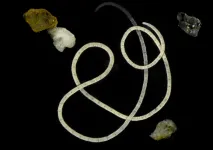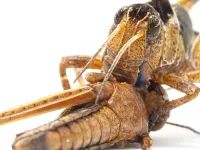(Press-News.org) May 4, 2023, Cleveland: Cleveland Clinic has been designated a Rare Disease Center of Excellence by the National Organization for Rare Disorders (NORD). The new Cleveland Clinic Center for Rare Diseases is one of 40 U.S. academic medical centers selected to join the first-of-it-kind national network dedicated to diagnosing, treating and researching all rare diseases.
The NORD Rare Disease Centers of Excellence program provides a much-needed national infrastructure to help accelerate advancements for rare diseases. The network of medical institutions, led by NORD, is designed to improve rare disease patient care by connecting patients to appropriate specialists regardless of disease or geography.
“By joining this national network, we can collaborate closely with other academic institutions to collectively improve care for the 25 million Americans who are affected by rare diseases,” said co-director of Cleveland Clinic Center for Rare Diseases Daniel Sullivan, M.D., Internal Medicine and Geriatrics. “As a NORD-recognized center, Cleveland Clinic will have access to resources and expertise from a large network of institutions working together to innovate around new treatments, therapies and research.”
Nearly one in 10 Americans has been diagnosed with a “rare disease” – a term used to classify a condition that affects fewer than 200,000 people. While more than 7,000 diseases are classified as rare, no treatments currently exist for 95% of these diseases.
“Unlike more common serious illnesses, people living with rare diseases face many challenges in finding a diagnosis and accessing quality care. Being part of this network provides us the structure to collaborate with other providers, and help more patients, throughout the country,” said Center for Rare Diseases director Julie Kaplan, M.D., medical director of Center for Personalized Genetic Healthcare. “With the resources that come with being recognized as a Center of Excellence, we can further enhance care and find the best solutions for each individual patient.”
The Cleveland Clinic Center for Rare Diseases focuses on meeting the needs of people with rare diseases through innovative research and clinical care. The center brings together experts from across Cleveland Clinic who provide care for patients with rare conditions including physicians, medical geneticists, pharmacists and genetic counselors from the Center for Personalized Genetic Healthcare. The center also includes the recently launched Undiagnosed Disease Clinic, which uses whole genome sequencing to help patients impacted by a rare, undiagnosed disease find a clinical diagnosis. These teams collaborate with scientists in Lerner Research Institute’s Genomic Medicine Institute, led by chairwoman Charis Eng, M.D., Ph.D., to drive rare disease research with the goal of better understanding multiple rare diseases.
“Right now, far too many rare diseases are without an established standard of care. The Rare Disease Centers of Excellence Program will help set that standard – for patients, clinicians, and medical centers alike,” said Ed Neilan, Chief Scientific and Medical Officer of NORD. “We are proud to announce Cleveland Clinic as a NORD Rare Disease Center of Excellence and look forward to their many further contributions as we collectively seek to improve health equity, care and research to support all individuals with rare diseases.”
For more information about the NORD Rare Disease Centers of Excellence Program, visit NORD’s website.
About Cleveland Clinic
Cleveland Clinic is a nonprofit multispecialty academic medical center that integrates clinical and hospital care with research and education. Located in Cleveland, Ohio, it was founded in 1921 by four renowned physicians with a vision of providing outstanding patient care based upon the principles of cooperation, compassion and innovation. Cleveland Clinic has pioneered many medical breakthroughs, including coronary artery bypass surgery and the first face transplant in the United States. U.S. News & World Report consistently names Cleveland Clinic as one of the nation’s best hospitals in its annual “America’s Best Hospitals” survey. Among Cleveland Clinic’s 77,000 employees worldwide are more than 5,658 salaried physicians and researchers, and 19,000 registered nurses and advanced practice providers, representing 140 medical specialties and subspecialties. Cleveland Clinic is a 6,665-bed health system that includes a 173-acre main campus near downtown Cleveland, 22 hospitals, more than 275 outpatient facilities, including locations in northeast Ohio; southeast Florida; Las Vegas, Nevada; Toronto, Canada; Abu Dhabi, UAE; and London, England. In 2022, there were 12.8 million outpatient encounters, 303,000 hospital admissions and observations, and 270,000 surgeries and procedures throughout Cleveland Clinic’s health system. Patients came for treatment from every state and 185 countries. Visit us at clevelandclinic.org. Follow us at twitter.com/ClevelandClinic. News and resources available at newsroom.clevelandclinic.org.
Editor’s Note: Cleveland Clinic News Service is available to provide broadcast-quality interviews and B-roll upon request.
END
Cleveland Clinic Rare Disease Center recognized as a National Center of Excellence by National Organization for Rare Disorders
Designation improves access to care for the 1 in 10 Americans living with a rare disease
2023-05-04
ELSE PRESS RELEASES FROM THIS DATE:
Adding epigenetic drug to standard chemotherapy was effective in pilot study for T-cell lymphoma
2023-05-04
Nearly 90 percent of patients with an aggressive subtype of non-Hodgkin lymphoma had their cancer go into remission in a small phase 2 clinical trial testing a treatment aimed at making chemotherapy more effective, according to Weill Cornell Medicine and NewYork-Presbyterian investigators.
The clinical trial, whose results were published May 4 in Blood, included 17 patients with a type of blood cancer called peripheral T-cell lymphoma with T-follicular helper phenotype (PTCL-TFH), also known as angioimmunoblastic T-cell lymphoma. Fifteen of them (88.2 percent) had complete ...
What really killed COVID-19 patients: it wasn’t a cytokine storm
2023-05-04
· No evidence of cytokine storm in critically ill patients with COVID-19
· Nearly half of patients with COVID-19 develop a secondary bacterial pneumonia
· Crucial to find and aggressively treat secondary bacterial pneumonia in ICU patients
CHICAGO --- Secondary bacterial infection of the lung (pneumonia) was extremely common in patients with COVID-19, affecting almost half the patients who required support from mechanical ventilation. By applying machine learning to medical record data, scientists at Northwestern University Feinberg School of Medicine found that secondary bacterial pneumonia that does not resolve was a key ...
Many older adults take multiple medications; an updated AGS Beers Criteria® will help ensure they are appropriate
2023-05-04
New York (May 4, 2023) — Today, the American Geriatrics Society (AGS) released the 2023 update to the AGS Beers Criteria® for Potentially Inappropriate Medication Use in Older Adults (DOI: 10.1111/jgs.18372). The AGS Beers Criteria® serves as a comprehensive list of medications that older people should potentially avoid or consider using with caution because they often present unnecessary risks for this population. Given that, according to the National Center for Health Statistics, United States (NCHSUS), more than 88% of older people use at least one prescription and more than 66% use ...
Study presents new clues about the rise of earth’s continents
2023-05-04
Continents are part of what makes Earth uniquely habitable for life among the planets of the solar system, yet surprisingly little is understood about what gave rise to these huge pieces of the planet’s crust and their special properties. New research from Elizabeth Cottrell, research geologist and curator of rocks at the Smithsonian’s National Museum of Natural History, and lead study author Megan Holycross, formerly a Peter Buck Fellow and National Science Foundation Fellow at the museum and now an assistant professor at Cornell University, deepens the understanding of Earth’s crust by testing ...
Converging ocean currents bring floating life and garbage together
2023-05-04
The North Pacific “Garbage Patch” is home to an abundance of floating sea creatures, as well as the plastic waste it has become famous for, according to a study by Rebecca Helm from Georgetown University, US, and colleagues, publishing April 27th in the open access journal PLOS Biology.
There are five main oceanic gyres — vortexes of water where multiple ocean currents meet — of which the North Pacific Subtropical Gyre (NPSG) is the largest. It is also known as the North Pacific “Garbage Patch”, because converging ocean currents have concentrated large amounts ...
Gutless marine worms on a Mediterranean diet: Animals can synthesize phytosterols
2023-05-04
Cholesterol and phytosterol are sterols, fatty compounds essential for many biological processes such as the functioning of cell membranes. Up to now, it has been assumed that phytosterols are characteristic for plants, and cholesterol for animals, and that only plants can make phytosterols, while animals typically make cholesterol. Dolma Michellod, Nicole Dubilier and Manuel Liebeke from the Max Planck Institute for Marine Microbiology in Bremen, Germany, were therefore surprised when they discovered that a small marine worm called Olavius ...
Scientists begin to unravel global role of atmospheric dust in nourishing oceans
2023-05-04
CORVALLIS, Ore. – New research led by an Oregon State University scientist begins to unravel the role dust plays in nourishing global ocean ecosystems while helping regulate atmospheric carbon dioxide levels.
Researchers have long known that phytoplankton – plantlike organisms that live in the upper part of the ocean and are the foundation of the marine food web – rely on dust from land-based sources for key nutrients. But the extent and magnitude of the impact of the dust – ...
Chemical signal protects migratory locusts from cannibalism
2023-05-04
Huge swarms of migratory locusts take on the proportions of natural disasters and threaten the food supply of millions of people, especially in Africa and Asia. As the eighth of the ten biblical plagues, the Book of Moses in the Old Testament already describes how swarms of locusts darkened the sky and ate up everything that grew in the fields and on the trees. Scientists suspect that cannibalism among locusts contributes to their swarming behavior, and swarms therefore constantly move ...
Pheromone deters swarming migratory locusts from cannibalism
2023-05-04
Swarming migratory locusts – which threaten food security across the globe – avoid being eaten by other locusts by producing a smelly pheromone called phenylacetonitrile (PAN), according to a new study. The discovery of an anticannibalistic signaling pathway in locusts could provide a target for locust management strategies since cannibalistic interactions among locusts have been implicated in creation of swarms, which are highly destructive. A wide range of species practice cannibalism, mostly to supplement nutrition. This has led to the evolution of ...
Social-belonging intervention promotes college success, increasing proportion of students who complete first year
2023-05-04
A randomized controlled experiment featuring more than 26,000 students across 22 4-year U.S. universities shows that the effects of a low-cost, brief online intervention focused on social belonging can promote success and equity for college students. This finding was particularly apparent among those from groups that have historically achieved at lower rates. The likelihood of earning a university degree in the U.S. is highly unequal across racial-ethnic and socioeconomic groups. In most cases, programs designed to help, by promoting college persistence, work differently for different people. Understanding these heterogenous effects ...
LAST 30 PRESS RELEASES:
Novel endocrine therapy giredestrant improves disease-free survival over standard of care for patients with early-stage breast cancer in phase III lidERA trial
Gen Z views world as "scary place" with growing cynicism about ability to create change
Biosensor performance doubled – New applications possible
Leveraging incomplete remote sensing for forest inventory
Key chemical in dark chocolate may slow down ageing
New 15-minute hepatitis C test paves the way for same-day treatment
Uranus and Neptune might be rock giants
Magnetically actuated soft electrodes for multisite bioelectrical monitoring of ex vivo tissues
FAU engineers decode dementia type using AI and EEG brainwave analysis
Carrier-free peptide–daunorubicin–small interfering RNA nanoassembly for targeted therapy of acute myeloid leukemia
Global Virus Network announces appointment of new board members
Artificial beaver dams show promise in offsetting climate change effects
Could hidden infections be fueling long COVID?
Targeted oxygen for initial resuscitation of preterm infants
Researchers develop models to help diagnose ALS earlier through blood biomarkers
Jeonbuk National University researchers develop novel eco-friendly and photo-switchable smart adhesives
Magnetic ordering induces Jahn–Teller effect in spinel-type compounds
A mitochondrial protein may hold the secret to longevity, new study finds
Study shows how everyday repairs sustain autonomy in a Japanese squat
Ancient manatee relative reveals that sea cows have engineered the Arabian Gulf’s seagrass ecosystems for over 20 million years
Fecal tests reveal active termite attacks
Uterine fibroids linked to elevated heart disease risk
Dual use of cigarettes and vapes can reduce risks of smoking and help smokers quit
New bioelectronics device based on hydrogel- elastomer conductive nanomembranes
More yield through heterosis: IPK research team decodes gene interaction
James Webb telescope reveals spectacular atmospheric escape
ICE-CSIC leads a pioneering study on the feasibility of asteroid mining
Dramatic rise in young people using mental health services
Be careful trusting TikTok for gout advice
A study by the University of Seville links the vanishing of the specific heats at absolute zero with the principle of entropy increase
[Press-News.org] Cleveland Clinic Rare Disease Center recognized as a National Center of Excellence by National Organization for Rare DisordersDesignation improves access to care for the 1 in 10 Americans living with a rare disease





